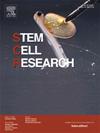两个在SRCAP基因浮港综合征位点发生杂合移码突变的iPSC系
IF 0.8
4区 医学
Q4 BIOTECHNOLOGY & APPLIED MICROBIOLOGY
引用次数: 0
摘要
我们提出了两个CRISPR/ cas9修饰的人类iPSC系,在SRCAP基因的flhs位点存在杂合移码突变(NM_006662.3:c.7300_7301insA),该突变与float - harbor综合征(一种先天性神经发育障碍,其症状包括身材矮小和智力残疾)有关。iPSCs表达多能性标记物OCT4、SOX2、NANOG和TRA 1-60。它们显示分化为来自所有3种胚层的细胞,在测试区域没有染色体异常和脱靶突变。这种突变导致了先前在患者中发现的停止密码子。因此,任何一种细胞系都可以作为FLHS背景下研究SRCAP的疾病特异性模型。本文章由计算机程序翻译,如有差异,请以英文原文为准。
Two iPSC lines with a heterozygous frameshift mutation in the floating-harbour syndrome locus of the SRCAP gene
We present two CRISPR/Cas9-modified human iPSC lines with a heterozygous frameshift mutation (NM_006662.3:c.7300_7301insA) in the FLHS-locus of the SRCAP gene, which is associated with Floating-Harbor syndrome, a congenital neurodevelopmental disorder with symptoms including short stature and intellectual disability. The iPSCs express the pluripotency markers OCT4, SOX2, NANOG and TRA 1-60. They show differentiation into cells from all 3 germ layers, no chromosomal abnormalities and no off-target mutations in the tested regions. The mutation leads to a stop codon previously found in patients. Thus, either cell line can serve as disease-specific model for studying SRCAP in the context of FLHS.
求助全文
通过发布文献求助,成功后即可免费获取论文全文。
去求助
来源期刊

Stem cell research
生物-生物工程与应用微生物
CiteScore
2.20
自引率
8.30%
发文量
338
审稿时长
55 days
期刊介绍:
Stem Cell Research is dedicated to publishing high-quality manuscripts focusing on the biology and applications of stem cell research. Submissions to Stem Cell Research, may cover all aspects of stem cells, including embryonic stem cells, tissue-specific stem cells, cancer stem cells, developmental studies, stem cell genomes, and translational research. Stem Cell Research publishes 6 issues a year.
 求助内容:
求助内容: 应助结果提醒方式:
应助结果提醒方式:


